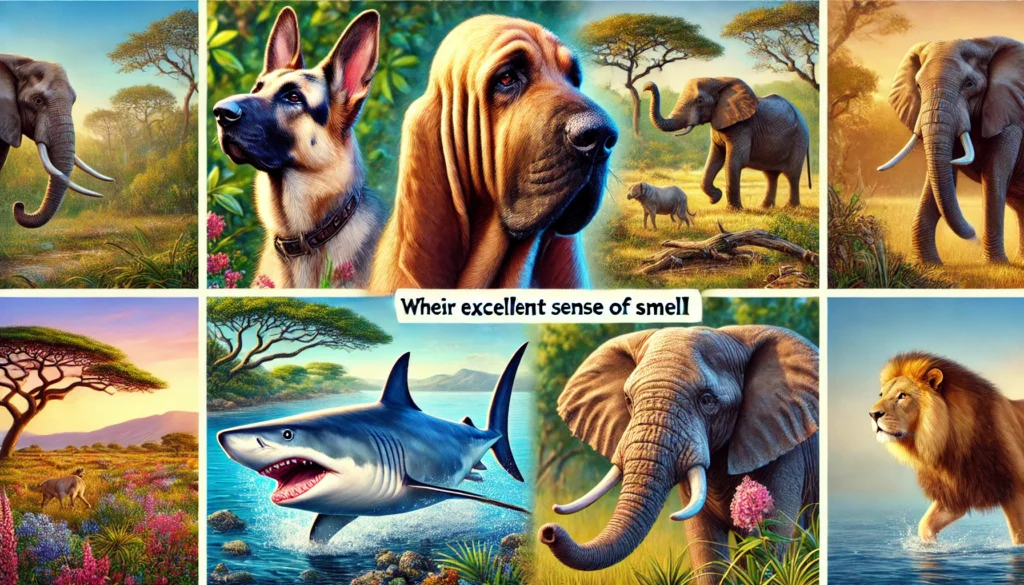In the animal kingdom, the sense of smell plays a crucial role in survival. From finding food to detecting predators, some animals rely heavily on their olfactory abilities to navigate their world. But which animal has the best sense of smell? While there are several contenders, this article will explore a few animals that stand out for their extraordinary noses, ultimately revealing the creature with the most powerful olfactory senses.
1. Bloodhound
When it comes to tracking scents on land, the bloodhound is unparalleled. This dog breed is known for its exceptional ability to follow a scent trail, even days after the trail was made. Bloodhounds have been used for centuries to track lost people, criminals, and missing animals due to their keen sense of smell.
The bloodhound’s nose contains around 300 million scent receptors, making it one of the most powerful scent-tracking animals. For comparison, humans have about 5 million scent receptors. A bloodhound’s sense of smell is so acute that it can pick up individual scents among hundreds, even in complex environments with multiple competing odors.
How Do Bloodhounds Track Scents?
Bloodhounds have long, droopy ears and loose, wrinkled skin around their faces. These features help funnel scent particles toward their noses as they move, making them incredibly efficient at picking up even the faintest odors.
2. Elephant
The elephant, particularly the African elephant, has one of the most sensitive noses in the animal kingdom. Elephants use their trunks not only to grab food and water but also to sniff out distant sources of food, water, and even other elephants.
Elephants possess around 2,000 olfactory receptor genes, the largest number among land animals. This allows them to detect scents over great distances—up to several miles away. Elephants can smell water sources from as far as 12 miles away, a vital skill in the arid environments where they often live.
Why Are Elephant Trunks So Efficient?
The elephant’s trunk is essentially a long, flexible nose, packed with olfactory receptors. This highly specialized organ allows elephants to detect subtle changes in the environment, making them highly sensitive to pheromones, food sources, and potential threats.
3. Great White Shark
While many land animals are known for their impressive olfactory abilities, some marine animals also have extraordinary senses of smell. The great white shark is one of them. Sharks have specialized organs called olfactory lamellae, which help them detect even the faintest trace of blood in the water.
Sharks can detect one drop of blood in a million drops of water, which makes them highly efficient predators. Their sense of smell helps them locate injured or weakened prey from long distances, even when they are miles away.
How Do Sharks Use Their Sense of Smell?
Sharks have two nostrils on the underside of their snouts that lead to olfactory bulbs in their brains. These bulbs process scent signals and help the shark determine the direction and distance of the source, making their sense of smell a critical hunting tool.
4. Moth
While most people associate powerful senses of smell with large animals, insects like moths have incredibly acute olfactory abilities. The silkmoth is particularly notable for its ability to detect pheromones emitted by female moths from miles away.
Male silkmoths have specialized antennae that can detect pheromone molecules in the air. These molecules guide the male to the female for mating. The sensitivity of a silkmoth’s sense of smell is so acute that it can detect just a few molecules of pheromone from several kilometers away.
What Makes Moths’ Smell so Sensitive?
Moths rely heavily on chemical signals for reproduction, and their antennae are lined with thousands of tiny hairs that detect airborne pheromones. These hairs are fine-tuned to pick up on the specific scent of female moths, allowing males to track potential mates across long distances.
5. Bear
Bears, particularly grizzly bears, have an extraordinary sense of smell. A bear’s sense of smell is estimated to be seven times stronger than that of a bloodhound. Bears use their noses to locate food sources, such as carcasses, ripe fruit, and even insect larvae hidden beneath the soil or in logs.
Grizzly bears can detect food sources from over 20 miles away, and their sense of smell is crucial for survival in environments where food can be scarce. Bears also use their olfactory senses to detect potential mates and to mark territory.
Why Is a Bear’s Sense of Smell So Powerful?
Bears have an exceptionally large olfactory bulb in their brains, which processes scent information. Their large nasal cavities allow them to take in more air and scent particles with each breath, enhancing their ability to detect even faint smells.
6. Salmon
Salmon are famous for their incredible ability to navigate back to their spawning grounds after spending years in the ocean. This is made possible by their extraordinary sense of smell. Salmon imprint on the unique scent of the river or stream where they were born and use this memory to return to the same location to spawn.
As salmon migrate from the ocean to freshwater rivers, they rely on their sense of smell to detect subtle chemical cues in the water, guiding them back to their natal streams with remarkable accuracy.
Olfactory Navigation in Salmon
Salmon’s sense of smell allows them to detect tiny chemical changes in the water, which helps them recognize their birthplace. This keen olfactory ability is essential for completing their life cycle and ensuring the next generation of salmon is born in the same waters.
7. Turkey Vulture
The turkey vulture is one of the few bird species with a highly developed sense of smell. While most birds rely primarily on sight and hearing, turkey vultures use their sense of smell to locate carrion (dead animals) from miles away. They are equipped with a highly developed olfactory bulb, which allows them to detect the gases produced by decomposing animals.
Turkey vultures are known to circle high in the sky, using both their sharp eyesight and sensitive noses to locate food. Once they pick up the scent of decay, they can pinpoint the source even in dense forests or hidden locations.
Adapted for Scavenging
Turkey vultures’ keen sense of smell makes them highly efficient scavengers, able to locate food from great distances. This adaptation allows them to survive in a variety of environments, from deserts to forests, where carrion can be difficult to spot.
8. Kiwi Bird
The kiwi, a flightless bird native to New Zealand, has a sense of smell that is unusually well-developed for a bird. Kiwis have nostrils located at the tip of their long beaks, allowing them to sniff out food as they probe the ground for insects, worms, and other invertebrates.
Kiwis rely on their sense of smell more than their eyesight, which is relatively weak. Their nocturnal lifestyle and ground-dwelling habits make this olfactory ability essential for survival in the dense forests and grasslands of New Zealand.
Smelling with Their Beaks
Unlike most birds, which use their beaks primarily for pecking and grasping, kiwis use their beaks to smell the ground as they search for food. Their unique olfactory system allows them to locate prey hidden beneath the soil.
9. Rats
Rats are well-known for their ability to detect food and danger using their acute sense of smell. Rats have highly sensitive noses that allow them to sniff out food sources, even when hidden or inaccessible. In urban environments, rats can detect food from far away, guiding them to sources of sustenance in complex environments.
Rats are also trained by humans to detect landmines and diseases like tuberculosis due to their highly developed olfactory abilities. Their ability to detect specific chemical compounds in tiny concentrations makes them valuable in search-and-rescue and medical diagnostics.
Training Rats to Smell Danger
Rats have been trained to detect explosives and diseases by associating specific scents with rewards. Their exceptional sense of smell allows them to identify dangerous chemicals or disease markers, making them useful in humanitarian work.
10. Snake
While snakes do not have noses like mammals, they possess an extraordinary sense of smell through their Jacobson’s organ, also known as the vomeronasal organ. This organ is located in the roof of a snake’s mouth and allows them to detect chemical particles in the air. Snakes use their forked tongues to pick up scent particles and then flick them back to the Jacobson’s organ for analysis.
This sense of smell is essential for detecting prey, predators, and mates. Snakes rely on their olfactory abilities to track down food, even when it is out of sight, using scent trails left by potential prey.
Sensing with Their Tongues
Snakes use their tongues to “taste” the air, picking up chemical cues that help them understand their surroundings. This olfactory system is highly sensitive and allows snakes to track prey, avoid predators, and find mates.
Conclusion
While many animals possess incredible senses of smell, some stand out for their extraordinary olfactory abilities. From the bloodhound’s unparalleled tracking skills to the elephant’s ability to detect water miles away, these creatures rely on their noses to navigate the world around them. However, the African elephant may take the crown for the best sense of smell among land animals due to its vast number of olfactory receptor genes. Whether it’s a shark detecting blood in the ocean or a moth sensing a mate’s pheromones, the animal kingdom is full of fascinating creatures that have evolved to make the most of their noses.
FAQ
What animal has the most powerful sense of smell?
The African elephant is considered to have the most powerful sense of smell among land animals, with about 2,000 olfactory receptor genes, allowing it to detect scents from miles away.
How far can a shark smell blood?
Sharks, particularly great whites, can detect one drop of blood in a million drops of water, enabling them to sense blood from several miles away.
Can dogs smell better than humans?
Yes, dogs have a far superior sense of smell compared to humans. Bloodhounds, for example, have around 300 million scent receptors, whereas humans have only 5 million.
Why do rats have such a good sense of smell?
Rats rely on their sense of smell to detect food, navigate complex environments, and avoid danger. Their keen olfactory abilities also allow them to be trained to detect landmines and diseases like tuberculosis.
Do birds have a good sense of smell?
Most birds rely more on their eyesight and hearing, but some species, like the turkey vulture and kiwi, have highly developed olfactory senses that help them find food and navigate their environments.
How do snakes smell?
Snakes use their tongues to pick up scent particles from the air, which are then transferred to their Jacobson’s organ, allowing them to detect prey, predators, and mates.


